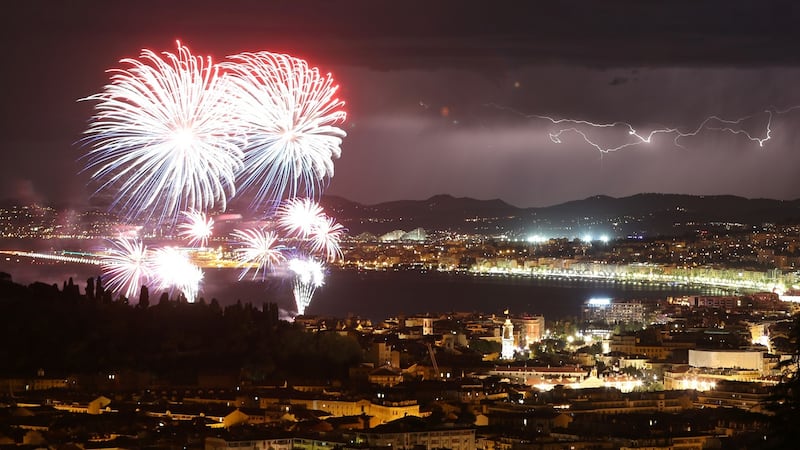The crackle-and-boom of the fireworks had begun just after 10pm, lighting up the night sky and sending cheers and whistles rippling through the multinational crowd of thousands who crammed the Promenade des Anglais.
Children threw stones into the glistening water. Friends clinked glasses on the hotel terraces. Across the road from the imposing art deco facade of the Palais de la Méditerranée hotel, where some of the biggest crowds had gathered, the mood was joyous and relaxed.
The fireworks display ended with a dazzling, thunderous crescendo just after 10.45pm. The crowd roared its approval. Some people turned back towards the city, ready to call it a day.

Others stayed put, savouring the atmosphere as another lazy Bastille Day petered out.
Farther along the road, at Lenval children’s hospital, less than 2km west of the hotel, a white, 19-tonne refrigerated lorry broke through a traffic barrier and turned left on to the seaside promenade.
At the wheel was 31-year-old Mohamed Lahouaiej Bouhlel, a Tunisian lorry driver who had a French residence permit and lived in Nice.
He was known to police for petty crimes but was not on a watch list of suspected militants.
He had one criminal conviction for road rage, having been sentenced to probation three months ago for throwing a wooden pallet at another driver.
Beside him in the cab on Thursday night were an automatic pistol, two replica assault rifles, a non-functioning grenade, a mobile phone and some papers.
As the lorry turned on to the promenade, the road was clear. The vehicle began to pick up speed.
It was just as people were beginning to stroll towards the old town that Auriane, a local resident, heard the first sounds.
"It was like fireworks – it didn't worry us," she told France Bleu Azur radio later.
Damien Allemand, a journalist with the Nice Matin newspaper, also thought little of it. He was making his way through the throng to get to his scooter when he heard a loud noise followed by screaming.
His first thought was that someone had tried to set off their own firework.
Some of the first screams had come from those who watched Fatima Charrihi die. The local woman, who was out watching the fireworks display from Magnan beach with her nieces and nephews, was the first to be killed when the lorry mounted the pavement and ploughed through the crowd.
“She was the first victim,” her son Hamza told L’Express. “There were no bodies before hers.”
Fatima’s husband, Ahmed, who was about 50 metres away, looked on in horror as the lorry sent bodies flying “like rags”.
One of her sons tried to resuscitate Fatima, but medics later told the family that, like most of the dead, she had been killed instantly.
Trail of bodies
The lorry continued on its route, swerving from the road to the path and back again, witnesses report, as if the driver was deliberately trying to hit as many people as possible.
As it passed it left a trail of prone bodies lying on the street in pools of blood. So heavy was the demand for blankets to cover the bodies later that night that tablecloths from nearby restaurants were used for the same purpose.
“Suddenly people started running in every direction, and immediately we thought of an attack,” Julia (29) a local woman, told Le Monde on Thursday night. They always knew it could happen some day, she said, but they didn’t expect it that night.
“We didn’t know what was happening, but we started to run as well. At one point I turned my head and I saw a lorry going very fast. It was zig-zagging on the road, and even went up on the embankment now and then. He was driving like a madman.”
Some onlookers at first thought it was an accident. Video footage taken by one witness shows a motorcyclist at one point coming alongside the driver’s cab, but the lorry appears to swerve towards the bike, pushing it away.
Richard Gutjahr, a German journalist who watched the massacre unfold from a window overlooking the promenade, told AFP that he saw a motorcyclist try to open the door of the lorry. "But he fell and he went under the wheels," Gutjahr added.
The lorry barrelled on, past some of Nice’s most famous beaches, tourist hotels and restaurants. Florida beach restaurant.
Voilier Plage. High Club. The Negresco hotel. By now, more than a minute after the vehicle had turned on to the promenade, the trail of still, prostrate bodies stretched to more than 1.7 km.
There was pandemonium on the promenade. Crowds of people were running down side streets and towards the safety of the old town.
Tourists took shelter in restaurants and in people’s homes, aware now that an attack was taking place but still confused as to what exactly was happening.
Near the Hotel Westminster, according to a number of reports, when the lorry slowed down to avoid hitting a pergola in its path, police fired shots at the vehicle.
Police fire
Gutjahr said he saw two police officers open fire. “Then the driver stepped on the accelerator and the truck sped up, accelerated and drove in a zigzag course into the crowd.
“In the next 15 to 20 seconds there were shots from several guns. I don’t know who shot at whom. The panicked crowd ran in all directions. Those who could save themselves ran into the hotels, or sought security in the hotel entrances.”
Still, on it went. When the lorry reached the Palais de la Méditerranée, where musicians had been playing just minutes earlier, the driver careered straight into the large crowd, killing about 30 people instantly.
“Bodies every five metres, limbs . . . Blood. Groans,” recalled Damien Allemand.
According to eyewitnesses cited by Le Figaro, an unidentified man at this point jumped up on the lorry and tried to tackle the driver, who reacted by firing out the window with a handgun.
The man jumped down, but two armed policemen returned fire and killed the driver. When police later examined the lorry, they counted more than 50 bullet holes.
All along the promenade, meanwhile, hotels and restaurants were being turned into field clinics.
The city’s hospitals activated their emergency plans, calling in reinforcements and scrambling to treat the scores of wounded.
At least 84 people were killed – including 10 children and teenagers – and 202 were wounded. "It was as if we had to deal with 100 car crashes at once, with numerous poly-traumas," Nicolas Venissac, a surgeon who was on duty on Thursday night, told Le Monde.
The emergency services had trained well, Venissac said, but nothing had prepared them for what they saw after the massacre.
“We had looked at all the scenarios – gun attacks, knife attacks, chemical weapons, explosions – but not an attack with a lorry.”



















